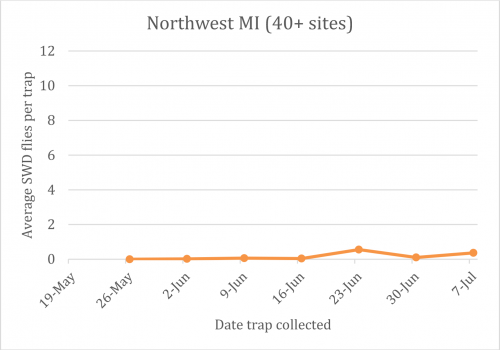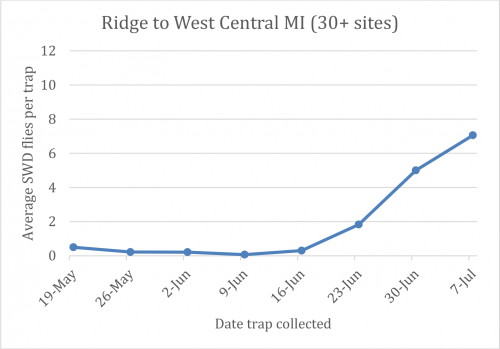Michigan spotted wing Drosophila report for July 11, 2017
Eighty percent of all SWD cup traps have captured SWD since the beginning of the season. Best practices for minimizing fruit infestation are reviewed. Start now!

Michigan State University Extension fruit team members continue to monitor for spotted wing Drosophila (SWD) across the fruit producing regions of Michigan with more than 140 traps set up in susceptible crops or non-crop hosts.
As of July 7, 2017, more than 80 percent of all the deli-cup style traps have caught adult SWD flies, with an average of seven SWD flies per trap each week for the last two weeks and a total of 720 SWD flies captured during the week of July 1–7. The graphs below show average numbers of SWD flies caught in traps each week starting the week ending in May 19.
SWD pressure is strong and early this season and growers of susceptible fruit should be prepared to manage this insect through their harvest season. When scouting for this pest, keep in mind the following:
- This pest reproduces very quickly, so it is unlike most other insects we manage in fruit farms. It behaves more like a rapidly spreading disease like cherry leaf spot or fire blight—if you fail to suppress it early, it will be extremely difficult to control later.
- You or your scout must take the time to look for female SWD flies in cup traps using a hand lens or, ideally, a microscope. Relying on a quick check in the field for male SWD in traps to decide when to apply your first control spray can result in infested fruit—females tend to be found in traps earlier than males.
A successful program for minimizing fruit infestation by SWD requires the use of a combination of best practices, including:
- Pruning the crop canopy for better air flow and less shading (SWD prefer shady, humid conditions) and to achieve better coverage of effective materials.
- Knowing when populations are on the rise by using proper scouting techniques combined with knowing your fruit is at a susceptible stage for infestation.
- Selecting and rotating insecticides with different modes of action that are rated EXCELLENT in terms of relative efficacy. (Don’t wait to use the best products until populations are out of control.)
- Proper sprayer calibration for complete canopy coverage.
- Applying materials at full cover and at the maximum rates recommended.
- Tight application intervals and reapplication after a rain event, especially if the material is known to have poor rainfastness.
- Harvesting fruit as soon as possible.
Traps that have been catching SWD flies so far this season are placed in blueberry (Allegan, Ionia, Montcalm, Ottawa, Van Buren), sweet cherry (Kent, Lenawee, Macomb), tart cherry (Allegan, Antrim, Benzie, Berrien, Grand Traverse, Leelanau, Manistee, Mason, Monroe, Oceana, Van Buren), grape (Allegan, Berrien, Ingham, Ionia, Van Buren), peach (Allegan, Berrien), plum (Van Buren), raspberry (Allegan, Ingham, Kent) and strawberry (Ionia, Livingston, Macomb, Ottawa,) blocks. Ripening fruit of susceptible crops in these counties are at risk of infestation by this pest.
Counties included in the 2017 trapping network are Allegan, Antrim, Benzie, Berrien, Grand Traverse, Ingham, Ionia, Kent, Leelanau, Lenawee, Livingston, Macomb, Manistee, Mason, Monroe, Montcalm, Muskegon, Oceana, Ottawa and Van Buren. All traps in the network are baited with commercially available lures and placed in susceptible crop fields or orchards, or in a location adjacent to susceptible crops. The majority of the traps this season are standard deli cup-style traps baited with the commercial Scentry brand lure. Most of the traps are placed in areas where SWD infestation has been recorded in the past.
For more information on this pest, including how to identify, monitor and manage this pest in fruit crops, please visit the MSU Spotted Wing Drosophila webpage.
SWD regional graphs
These graphs show the average number of SWD flies caught in traps baited with lures for the past seven to eight weeks. Our efforts reveal that the surge in the average number of SWD flies caught in traps has occurred three to four weeks earlier than last year, which means populations that are big enough to cause serious damage are occurring earlier than ever before, with the usual lag expected between southwest and northwest regions.

Northwest Michigan (40+ sites).

Ridge to west central Michigan (30+ sites).

Southwest to southeast Michigan (50+ sites).



 Print
Print Email
Email
